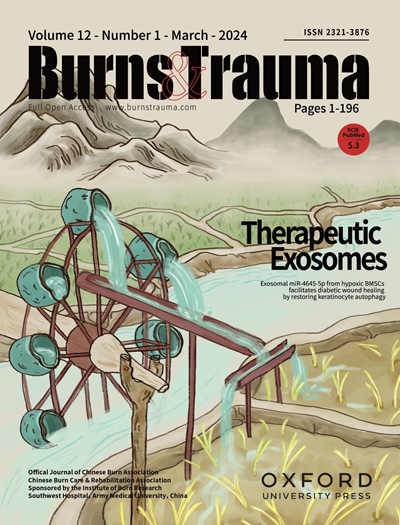外泌体在糖尿病创面愈合中的研究进展
IF 9.6
1区 医学
Q1 DERMATOLOGY
引用次数: 0
摘要
伤口愈合不良是一个难治性的过程,给糖尿病患者带来了巨大的医疗和经济负担。外泌体最近被认为是糖尿病病变愈合的关键参与者。作为一种新型的无细胞疗法,它们具有良好的稳定性、归巢效应、生物相容性和降低的免疫原性。除了将货物运输到靶细胞以增强细胞间通讯外,外泌体在糖尿病伤口愈合的几乎每个阶段都是有益的。它们参与调节炎症反应,加速增殖和再上皮化,增加血管生成,调节细胞外基质重塑。越来越多的证据表明,与外泌体结合的水凝胶或敷料可以延长外泌体在糖尿病伤口中的停留时间。本文综述了外泌体在糖尿病伤口修复中的作用机制、递送、临床应用、工程以及存在的挑战。我们还提出了包含外泌体的生物材料的未来发展方向:2D或3D支架,负载伤口愈合气体的生物材料,智能生物材料以及外泌体系统应用的前景。这些发现可能会对未来的治疗和改善糖尿病患者生活质量的研究有所启发。本文章由计算机程序翻译,如有差异,请以英文原文为准。
Advances of exosomes in diabetic wound healing
Poor wound healing is a refractory process that places an enormous medical and financial burden on diabetic patients. Exosomes have recently been recognized as crucial players in the healing of diabetic lesions. They have excellent stability, homing effects, biocompatibility, and reduced immunogenicity as novel cell-free therapies. In addition to transporting cargos to target cells to enhance intercellular communication, exosomes are beneficial in nearly every phase of diabetic wound healing. They participate in modulating the inflammatory response, accelerating proliferation and reepithelization, increasing angiogenesis, and regulating extracellular matrix remodeling. Accumulating evidence indicates that hydrogels or dressings in conjunction with exosomes can prolong the duration of exosome residency in diabetic wounds. This review provides an overview of the mechanisms, delivery, clinical application, engineering, and existing challenges of the use of exosomes in diabetic wound repair. We also propose future directions for biomaterials incorporating exosomes: 2D or 3D scaffolds, biomaterials loaded with wound healing-promoting gases, intelligent biomaterials, and the prospect of systematic application of exosomes. These findings may might shed light on future treatments and enlighten some studies to improve quality of life among diabetes patients.
求助全文
通过发布文献求助,成功后即可免费获取论文全文。
去求助
来源期刊

Burns & Trauma
医学-皮肤病学
CiteScore
8.40
自引率
9.40%
发文量
186
审稿时长
6 weeks
期刊介绍:
The first open access journal in the field of burns and trauma injury in the Asia-Pacific region, Burns & Trauma publishes the latest developments in basic, clinical and translational research in the field. With a special focus on prevention, clinical treatment and basic research, the journal welcomes submissions in various aspects of biomaterials, tissue engineering, stem cells, critical care, immunobiology, skin transplantation, and the prevention and regeneration of burns and trauma injuries. With an expert Editorial Board and a team of dedicated scientific editors, the journal enjoys a large readership and is supported by Southwest Hospital, which covers authors'' article processing charges.
 求助内容:
求助内容: 应助结果提醒方式:
应助结果提醒方式:


